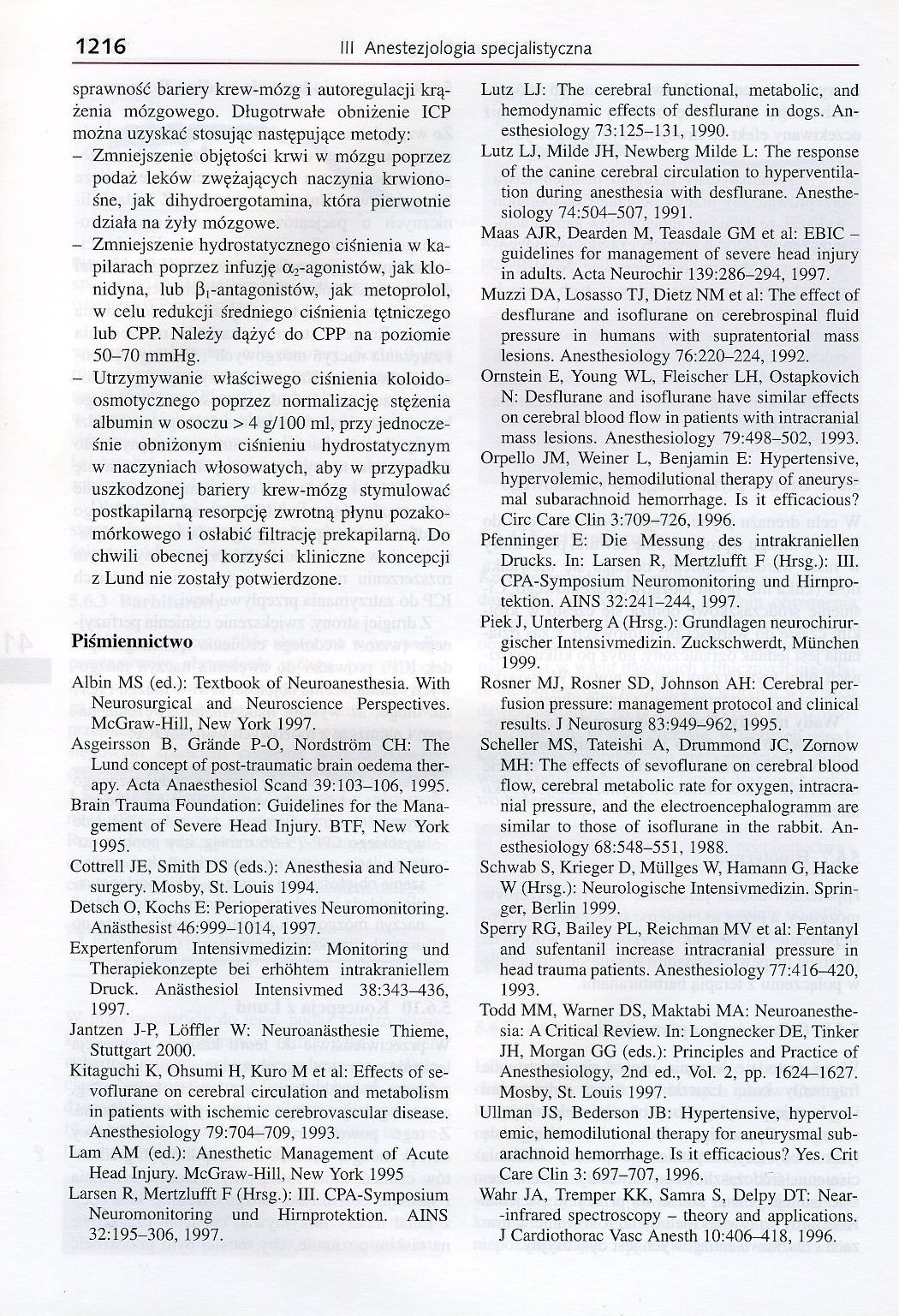larsen1216

1216 III Anestezjologia specjalistyczna
sprawność bariery krew-mózg i autoregulacji krążenia mózgowego. Długotrwałe obniżenie ICP
można uzyskać stosując następujące metody:
- Zmniejszenie objętości krwi w mózgu poprzez podaż leków zwężających naczynia krwionośnie, jak dihydroergotamina, która pierwotnie działa na żyły mózgowe.
- Zmniejszenie hydrostatycznego ciśnienia w ka-pilarach poprzez infuzję oci-agonistów, jak klo-nidyna, lub (5,-antagonistów, jak metoprolol, w celu redukcji średniego ciśnienia tętniczego lub CPP. Należy dążyć do CPP na poziomie 50-70 mmHg.
- Utrzymywanie właściwego ciśnienia koloido-osmotycznego poprzez normalizację stężenia albumin w osoczu > 4 g/100 ml, przy jednocześnie obniżonym ciśnieniu hydrostatycznym w naczyniach włosowatych, aby w przypadku uszkodzonej bariery krew-mózg stymulować postkapilarną resorpcję zwrotną płynu pozako-mórkowego i osłabić filtrację prekapilamą. Do chwili obecnej korzyści kliniczne koncepcji z Lund nie zostały potwierdzone.
Piśmiennictwo
Albin MS (ed.): Textbook of Neuroanesthesia. With Neurosurgical and Neuroscience Perspectives. McGraw-Hill, New York 1997.
Asgeirsson B, Grandę P-O, Nordstrom CH: The Lund concept of post-traumatic brain oedema ther-apy. Acta Anaesthesiol Scand 39:103-106, 1995.
Brain Trauma Foundation: Guidelines for the Management of Severe Head Injury. BTF, New York 1995.
Cottrell JE, Smith DS (eds.): Anesthesia and Neuro-surgery. Mosby, St. Louis 1994.
Detsch O, Kochs E: Perioperatives Neuromonitoring. Anasthesist 46:999-1014, 1997.
Expertenforum Intensivmedizin: Monitoring und Therapiekonzepte bei erhohtem intrakraniellem Druck. Anasthesiol Intensivmed 38:343—436, 1997.
Jantzen J-P, Lóffler W: Neuroanasthesie Thieme, Stuttgart 2000.
Kitaguchi K, Ohsumi H, Kuro M et al: Effects of se-voflurane on cerebral circulation and metabolism in patients with ischemic cerebrovascular disease. Anesthesiology 79:704-709, 1993.
Lam AM (ed.): Anesthetic Management of Acute Head Injury. McGraw-Hill, New York 1995
Larsen R, Mertzlufft F (Hrsg.): 111. CPA-Symposium Neuromonitoring und Hirnprotektion. AINS 32:195-306, 1997.
Lutz LJ: The cerebral functional, metabolic, and hemodynamic effects of desflurane in dogs. Anesthesiology 73:125-131, 1990.
Lutz LJ, Milde JH, Newberg Milde L: The response of the canine cerebral circulation to hyperventila-tion during anesthesia with desflurane. Anesthesiology 74:504-507, 1991.
Maas AJR, Dearden M, Teasdale GM et al: EBIC -guidelines for management of severe head injury in adults. Acta Neurochir 139:286-294, 1997.
Muzzi DA, Losasso TJ, Dietz NM et al: The effect of desflurane and isoflurane on cerebrospinal fluid pressure in humans with supratentorial mass lesions. Anesthesiology 76:220-224, 1992.
Ornstein E, Young WL, Fleischer LH, Ostapkovich N: Desflurane and isoflurane have similar effects on cerebral blood flow in patients with intracranial mass lesions. Anesthesiology 79:498-502, 1993.
Orpello JM, Weiner L, Benjamin E: Hypertensive, hypervolemic, hemodilutional therapy of aneurys-mal subarachnoid hemorrhage. Is it efficacious? Circ Care Clin 3:709-726, 1996.
Pfenninger E: Die Messung des intrakraniellen Drucks. In: Larsen R, Mertzlufft F (Hrsg.): III. CPA-Symposium Neuromonitoring und Hirnprotektion. AINS 32:241-244, 1997.
Piek J, Unterberg A (Hrsg.): Grundlagen neurochirur-gischer Intensivmedizin. Zuckschwerdt, Miinchen 1999.
Rosner MJ, Rosner SD, Johnson AH: Cerebral per-fusion pressure: management protocol and clinical results. J Neurosurg 83:949-962, 1995.
Scheller MS, Tateishi A, Drummond JC, Zomow MH: The effects of sevoflurane on cerebral blood flow, cerebral metabolic ratę for oxygen, intracranial pressure, and the electroencephalogramm are similar to those of isoflurane in the rabbit. Anesthesiology 68:548-551, 1988.
Schwab S, Krieger D, Mullges W, Hamann G, Hacke W (Hrsg.): Neurologische Intensivmedizin. Springer, Berlin 1999.
Sperry RG, Bailey PL, Reichman MV et al: Fentanyl and sufentanil increase intracranial pressure in head trauma patients. Anesthesiology 77:416-420, 1993.
Todd MM, Warner DS, Maktabi MA: Neuroanesthesia: A Critical Review. In: Longnecker DE, Tinker JH, Morgan GG (eds.): Principles and Practice of Anesthesiology, 2nd ed., Vol. 2, pp. 1624-1627. Mosby. St. Louis 1997.
Ullman JS, Bederson JB: Hypertensive, hypervol-emic, hemodilutional therapy for aneurysmal subarachnoid hemorrhage. Is it efficacious? Yes. Crit Care Clin 3: 697-707, 1996.
Wahr JA, Tremper KK, Samra S, Delpy DT: Near--infrared spectroscopy - theory and applications. J Cardiothorac Vasc Anesth 10:406-418, 1996.
Wyszukiwarka
Podobne podstrony:
larsen1254 1254 III Anestezjologia specjalistyczna krwawieniem, przed zabiegiem należy przygotować k
larsen1226 1226 III Anestezjologia specjalistyczna oka. Oko operowane jest zabezpieczone metalową pł
larsen0984 984 III Anestezjologia specjalistyczna 984 III Anestezjologia specjalistyczna 7.3.9
larsen0986 986 III Anestezjologia specjalistyczna Wartos ci gazometryczne u ciężarnych: - &nbs
larsen0988 988 III Anestezjologia specjalistyczna Objętość osocza i komórkowa część składowa krwi ni
larsen0992 992 III Anestezjologia specjalistyczna „Stężenie analgetyczjne" halotanu, enfluranu,
larsen0994 994 III Anestezjologia specjalistyczna żający życiu obrzęk płuc, nawet w ostatnim trymest
larsen0996 996 III Anestezjologia specjalistyczna zależy od tego, czy środek jest iipofilny i niezjo
larsen0998 998 III Anestezjologia specjalistyczna 998 III Anestezjologia specjalistyczna ż. główna g
larsen1000 1000 III Anestezjologia specjalistyczna Ten zespół prawdopodobnie występuje tylko wtedy,
larsen1002 1002 III Anestezjologia specjalistyczna Tabela 37.3 Iloraz stężeń amidowych środków
larsen1004 1004 III Anestezjologia specjalistyczna ■ Prawidłowa wartość częstości akcji serca płodu
larsen1006 1006 III Anestezjologia specjalistyczna Ryc. 37.4. Drogi przewodzenia bólu porodowego. W
larsen1010 1010 III Anestezjologia specjalistyczna Znieczulenia zewnątrzoponowe w położnictwie. Syst
larsen1012 1012 III Anestezjologia specjalistyczna cje, aby utrzymać dobrą analgezję, także liczba s
larsen1014 1014 III Anestezjologia specjalistyczna Tabela 37.4 Opioidy podawane podpajęczynówkowo po
larsen1016 1016 III Anestezjologia specjalistyczna nowej. Najrzadziej do jednostronnego znieczulenia
larsen1018 1018 III Anestezjologia specjalistyczna 6.2.11 Podział zadań - współpraca anestezjologa z
larsen1020 1020 III Anestezjologia specjalistyczna - rodzaju wskazań do operacji,
więcej podobnych podstron